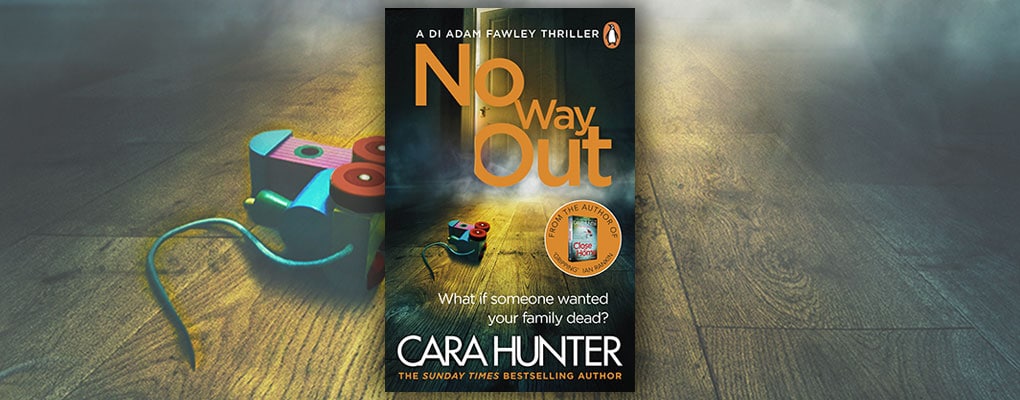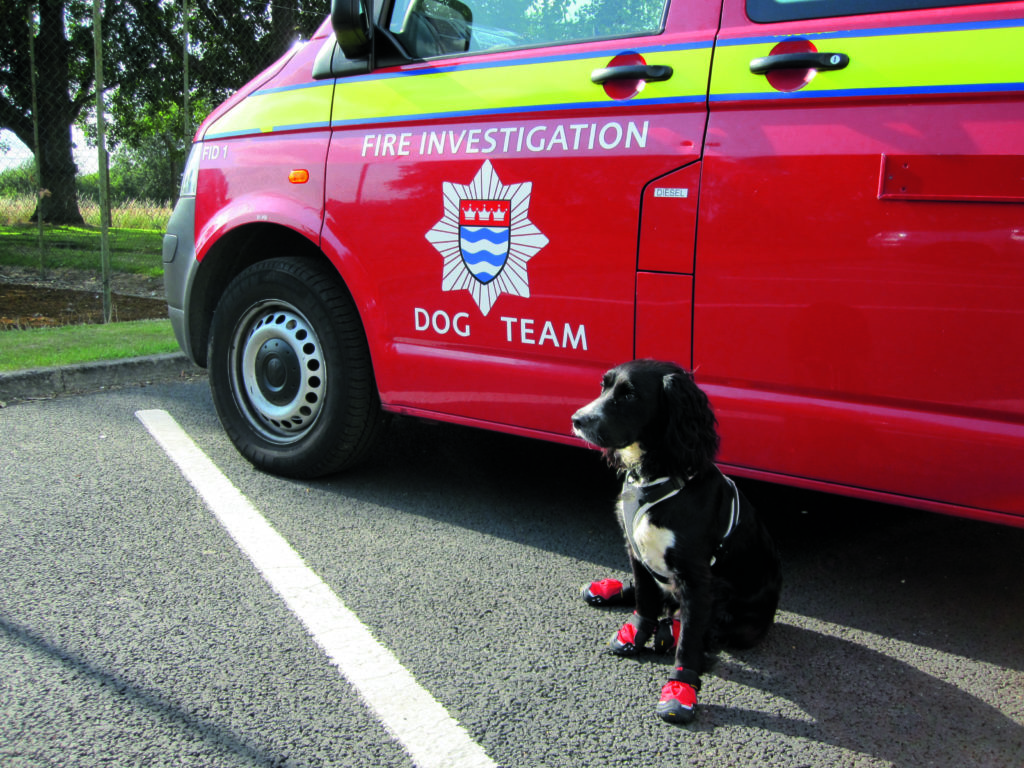On the scene: the Fire Scene Investigator
My ambition for the DI Fawley series was to write books which allow the reader to feel as though they’re looking over the shoulder of a real investigative team. I’ve always wanted my books to have not just pace but immediacy – a real sense of what the process is like, and the sort of challenges actual investigators face. But if you’re going to write a crime book that way it puts a lot more onus on you to get your facts right. That’s why I’m so lucky to have a really experienced team of professional advisers to help me.
No Way Out begins with a terrible fire at a large house in north Oxford, and the opening scene is a transcript of the firefighters’ communications as they arrive at the scene and start to tackle the fire. The investigation of that fire was going to be one of the main planks of the story, so I needed to understand that process from the inside. I needed to talk to actual firefighters.
I was in luck though, because a friend was able to introduce me to Graham Turner, who was then Station Manager at Oxford’s Rewley Road fire station (he’s since retired), and Steve Johns, a senior fire scene investigator.
For the first in our series of interviews with the ‘pro team’, I went back to Rewley Road and talked to Steve again about what his work involves, and how an expert like him works out whether a fire is just an unfortunate accident or something far more suspicious…
Let’s start at the beginning – the 999 call. What happens when someone calls to report a fire?
We have a centralised control room, covering the whole of the Thames Valley. When someone makes an emergency call, they’ll take the details and work out where the nearest fire station is. Depending on what sort of fire it is, there’s a standard ‘pre-determined attendance’. House fires, for example, will always be attended by three fire engines (usually from two different fire stations), and one Level 2 officer.
The person in charge of the first appliance to reach the scene will take control of the scene as Incident Commander. They rarely go inside – their job is to manage the scene, assess risk, and talk to the firefighters who are actually tackling the fire. They’ll also liaise with the police if they’re on site too, and talk to the owner of the property or the person who rang 999 to see what they know about how it might have started. If a fire’s accidental, there’s usually someone who has a pretty good idea how it happened.
How soon would an experienced fire investigator realise they might be looking at arson?
The biggest giveaway is the speed of spread. If a fire starts by accident – if someone drops a cigarette, say – the fire will tend to smoulder for a while before really taking hold, but a fire set deliberately will gather pace much more quickly, especially if accelerant is used.
TV fire investigators often deduce the use of accelerant from patterns on floors or walls, or from the smell – does that happen in real life?
The main issue with accelerant is that those fires burn so fast that any patterning is usually long gone before you get there. As for the smell, accelerant does have quite a distinctive odour, but oil-based carpets and other materials smell very similar if they’re burned, so it’s not a reliable guide, at least to a human nose. But we can get a Fire Investigation Dog out if we need to.
I had no idea there were Fire Investigation Dogs!
Oh yes, there are quite a few! There used to be one in Buckinghamshire, but these days our nearest are in London, Birmingham and Hampshire.
Sherlock is a much loved member of the London Fire Brigade.
Is a Fire Investigation Dog a bit like a cadaver dog or a drug-detection dog?
Yes, they’re trained to pick up specific accelerant smells, and if they identify a particular area as suspicious the police CSI will take samples and carry out proper testing on them.
So what else do you look for?
Where a fire started can tell you a lot – for example, whether it was near any sort of appliance or power socket. I attended one fire that had clearly started on the front door mat. We did a thorough inspection of the area but there was nothing in the vicinity that could have sparked a blaze: no faulty wires, no heaters, nothing. The only possibility left was deliberate arson, from something someone must have put through the letter box, which was what the residents had suspected all along. That was one where we got a Fire Dog in to check the area.
And when do the police get involved?
Sometimes they’ll attend the scene even if it’s pretty clear it’s accidental – if we need help managing traffic, for example. But if there’s any suspicion of arson we have to hand over to the police straight away, because it’s their responsibility to investigate crime. Once the building has been made safe, we’ll start work alongside the police CSIs.
We start by establishing the Point of Origin. Fire moves upwards, so you’re looking for a Point of Origin lower down than most of the more obvious damage. The skirting board is usually a good indicator – at the Point of Origin, the board will be very badly burnt, but on the opposite side of the room there may be very little damage to it at all. That’s because the fire will travel up the wall from its origin, then across the ceiling. Burning light fittings may then drop down onto furniture and carpets below, and you can easily determine where that’s happened because the items will be more badly burned at the top than the base. But a chair with the origin of the fire right behind it will be more burned at the back than the front.
Which is all very logical, when you think about it.
Right, it sounds fairly straightforward, but your average fire scene will be complete chaos, so it can take time to find what you’re looking for. And fire crews’ first priority is to save lives and extinguish the flames, so they may well move furniture about in the course of doing that. But you can always ask the crew back in later and say, ‘Right, when you came in here can you remember what it looked like?’ They can also tell you whether doors were open or shut when they arrived on the scene, and whether the windows were intact.
What happens next?
Probably the most critical phase is digging out the scene, which is exactly what it sounds like: getting down on your hands and knees in protective clothing and sifting through the debris for evidence. That’s a painstaking job, and you have to know what you’re looking for, and what the potential hazards are too. That process takes at least a couple of days, depending on the size of the fire, and in a suspected arson we’d do that in tandem with the police CSIs. We also take a lot of pictures at the scene, which are burned onto DVDs, so they are a reliable source of evidence, and we can be prove they haven’t been tampered with or photoshopped.
Once you have your evidence you can start trying to draw some conclusions. We do a lot of brainstorming at this stage, because the danger is you jump to the obvious conclusion, when in fact it could be something more complex, so I always challenge myself to go through all the possibilities, however unlikely they might seem. So we’ll confer and go through the scenarios – what if there was a power surge – does the electricity company have any record of something like that occurring at the time? If it was the heater, what would we expect to see? Does that tally with the evidence?
Do you have software that helps you do that?
No – just experience!
When you’ve gone through all the possibilities and eliminated anything that doesn’t fit, what you’re left with is the probable cause. We then feed that into the report, which follows a standard template, and includes a floor-plan showing plug sockets, appliances, heaters etc. That’s what gets submitted to the coroner, and added to the case file if there’s a criminal prosecution.
And that’s basically it – the A-Z of fire scene investigation.
Anyone who has read No Way Out will recognise the report Steve’s talking about straightaway. It’s the basis for the one I include in the book, which Steve helped me to compile, though the fictional one is much shorter. He also told me about the time his team were called to a house fire, which the owner claimed was arson. It started in the garden, spread to the decking, and then to the house. Steve and the police CSI realised quite quickly that no arsonist could possibly have set a fire where this one had started. So what could possibly have happened? The answer, as it turned out, was simple: the owner had been reading on the decking and got so angry with the book that she’d thrown it in the flower bed and set it on fire.
So be warned, dear reader – a blazing Amazon review is a whole lot safer than the real thing…
PS. in case you’re wondering, it wasn’t one of mine! ?
1 Comment
Join the discussion
Please note: Moderation is enabled and may delay your comment being posted. There is no need to resubmit your comment. By posting a comment you are agreeing to the website Terms of Use.



Have read Close to Home
Just ordered In the Dark
Cara great writer